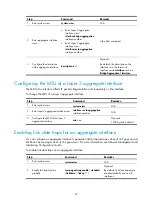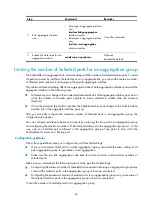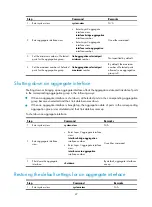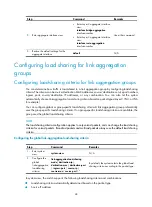
38
Figure 11
Setting the aggregation state of a member port in a static aggregation group
Aggregating links in dynamic mode
LACP is automatically enabled on all member ports in a dynamic aggregation group. The protocol
automatically maintains the aggregation state of ports.
The dynamic link aggregation process comprises:
•
•
Setting the aggregation state of each member port
Selecting a reference port
The local system (the actor) and the remote system (the partner) negotiate a reference port using the
following workflow:
1.
The systems compare the system ID (which comprises the system LACP priority and the system
MAC address). The system with the lower LACP priority value wins. If they are the same, the
systems compare the system MAC addresses. The system with the lower MAC address wins.
2.
The system with the smaller system ID selects the port with the smallest port ID as the reference port.
A port ID comprises a port aggregation priority and a port number. The port with the lower
aggregation priority value wins. If two ports have the same aggregation priority, the system
compares their port numbers. The port with the smaller port number wins.
Setting the aggregation state of each member port
After the reference port is selected, the system with the lower system ID sets the state of each member port
in the dynamic aggregation group on its side.
No
Port attribute/class 2 configurations
same as the reference port?
More candidate ports than max.
number of Selected ports?
Is the port up?
Is there any hardware restriction?
Port number as low as to set
the port in the Selected state?
Set the aggregation state
of a member port
Set the port in the Selected state
Set the port in the
Unselected state
Yes
Yes
No
Yes
No
Yes
No
Yes
No






























